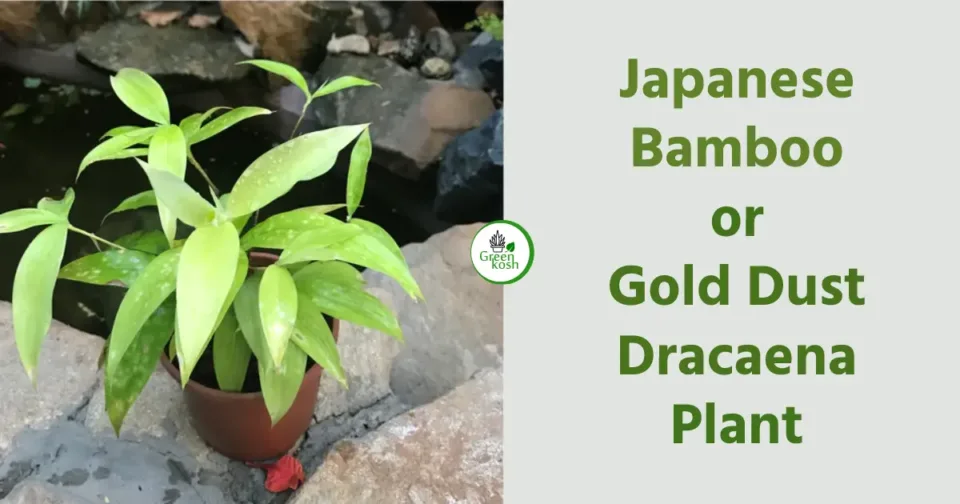Japanese Bamboo is also known as Gold Dust Dracaena and scientifically named Dracaena Surculosa Punctulata, belongs to the Dracaenaceae family and is natively associated with Western Tropical Africa.
The Japanese Bamboo plant looks similar to an ornamental bamboo and bears oval-shaped leaves that can grow up to the length of 20 cm. The leaves are usually dark green and have yellowish-green spots that turn into a yellowish-white shade with age.

Alongside the leaves, the Japanese Bamboo bears whitish flowers in clusters that smell pleasantly during the evenings. You can even notice small berries after the flowers fall off if you have kept the plant for a long time.
How to care for Japanese bamboo Indoor plants?
As mentioned earlier, Japanese Bamboo is an indoor plant that you can arrange at different corners of your house or office for a great aesthetic. But while the plant is offering an impressive touch to your interiors, it is also essential that you show some responsibility towards it by taking care of it.
- The plant requires moderate watering. The basic rule is to keep the soil moist without overdoing it. Watering the plant once a week is a great idea. Also, if the weather is too dry, you should keep a check and water it if the soil has dried up.
- The Bamboo needs indirect sunlight as direct sun rays tend to burn the leaves. So, keep the planter in a place where it gets ample natural light but can stay safe from direct sun rays.
- Shedding any yellow or dead leaves will keep the plant tidy to look at. Also, cutting out any branch growing too lengthy or not in sync with the other branches will keep the plant in proper shape.
- For extra care, use a mild fertilizer once a month and a humidifier if the atmosphere is too dry.
Maintaining these care tips will not just let the plant survive for a long time but also help add a pleasant look to your home or office interiors.
Japanese Bamboo Feng Shui Plant
Japanese Bamboo is an indoor plant that is usually kept for good luck and a great interior look.
Japanese Bamboo is one of the favorites in Feng Shui and is known by the name Lucky Bamboo. According to Feng Shui, Japanese Bamboo is a powerful plant for overall wellness and harmony in your home or office.

The Japanese Bamboo plant represents the element wood which is believed to create a balance among other elements. The plant grows in a unique shape of intertwined stalks that symbolize strength, resilience, and unity. Moreover, Feng Shui enthusiasts will suggest Japanese Bamboo for an environment of prosperity, great fortune, and positive energy around you.
Benefits of Japanese Bamboo Indoor Plant
In recent years, the demand for Japanese Bamboo as an indoor plant has spiked because of several benefits. Here are some of the common benefits because of which you can also plan to get an indoor plant of Japanese Bamboo for your home or office.
- It helps in purifying the air and maintaining a clean atmosphere.
- The plant is very much known for its ability to attract positive energy.
- As it is a wood element, the plant helps in striking a balance among other elements of the environment.
- Japanese Bamboo enhances great health as well as luck.
- You do not have to put much effort into its maintenance.
- The plant also beautifies your interiors.
Get your personal Japanese Bamboo indoor plant to experience these fantastic benefits.
Japanese Bamboo Indoor Plant Uses
Japanese Bamboo has been used indoors for its various aesthetic, medicinal properties, and uses.
1. Landscape Uses:
Dracaena Surculosa, or Japanese Bamboo, is an indoor plant mostly used for beautifying your office or residential interiors. The plant is usually put in a planter pot as ornamental foliage to install at the eminent corners of any room. If the bamboo plant’s height is short, install it on the table.

While Japanese Bamboo is mainly kept indoors, there are also instances where it is used for indoor garden concepts. If you plan to build a small water feature such as a fountain or so at the entrance or porch area, installing these bamboo plants can offer a unique characteristic to the area. Also, you can create a green wall using Japanese Bamboo plants that can reflect an exceptional landscaping idea.
2. Medicinal Uses
Apart from purifying the air and maintaining a balance in the environment, Japanese Bamboo is also known for its exceptional medicinal uses. The plant is known to have several beneficial medicinal properties such as anti-inflammatory, antiviral, and antioxidant. Also, the plant is extremely helpful in treating or preventing several health concerns, such as diarrhea, ulcer, and tumor. It has also been noticed that the plant has the property of wound healing.
Some specific parts of the plant help treat different diseases. For example, the plant’s root treats problems such as parasitic infections. Similarly, the leaf sap can cure debility, malnutrition, epilepsy, paralysis, spasms, and convulsions.
FAQs
Q1: Does the Japanese Bamboo plant have a fragrance?
Japanese Bamboo is a non-fragrant plant, but when it bears flowers, you can get a pleasant smell during the evenings.
Q2: Can you keep Japanese Bamboo outdoors?
Japanese Bamboo requires indirect sunlight as direct sunrays can burn its leaves. Hence, though it is recommended to keep it outdoors, you can install it under a shade that protects it from direct sun rays, such as on the balcony or the porch area of the house.
Q3: Is Japanese Bamboo harmful?
Usually, Japanese Bamboo is known for its medicinal properties and various benefits. Still, the fruits and flowers of the plant can get poisonous for some animals, especially pets such as cats and dogs.
